Italian actor and stage director Annibale Betrone (1883-1950) was an important figure of the Italian theatre of the first half of the 20th century.

Italian postcard by A. Traldi, Milano, no. 29. Photo: Badodi, Milano.
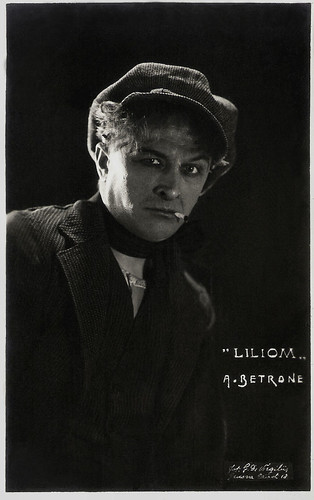
Italian postcard. Photo: G. Di Virgiliis, Genova. Annibale Betrone as Liliom in the play 'La leggenda di Liliom' by Hungarian playwright Ferenc Molnár. Liliom was one of Betrone's best-known stage roles.

Italian postcard by G. Vettori, Bologna, no. 435. Photo: Vettori, Bologna.
Annibale Betrone was born in Turin in 1883. Unlike many of his stage colleagues, he was no ‘figlio d’arte’, his father was a tailor, who was passionate about the stage. Annibale found a way to study acting with Domenico Bassi.
His debut came at the age of 17, in 1900, with the title of ‘second actor’ in the company of the brothers Marchetti. He was then hired by the company of Ermete Novelli, with whom he remained from 1901 to 1908. He passed the whole trajectory going from extra, to lover, to the young first actor, and finally the first actor.
He then moved over to Virgilio Talli’s company for a long period (1909-1921), where he established a famous triad with Maria Melato and Alberto Giovannini.
Between the two wars, he formed famous companies with some of the most reputed actresses, such as Maria Melato, Giannina Chiantoni, Tatiana Pavlova, Emma Gramatica, Paola Borboni, Kiki Palmer, Margaret Bagni, Olga Solbelli, and many more.
Betrone was an actor of a strong dramatic, sometimes explosive, temperament, and moved around within a vast repertory. He achieved great fame. Among his greatest successes are 'Il beffardo' by Nino Berrini and 'Glauco' by Ercole Luigi Morselli. He also played in 'Anfissa' by Leonid Andreev and in 'La sonata di Kreutzer' (The Kreutzer Sonata) by François Nozières, after Leo Tolstoy.
He was Bruneri-Canella in 'L’uomo no. 15' by E. Wool, and also recited in plays by Rosso di San Secondo ('Il delirio dell’oste Bassà') and Diego Fabbri. In 1945, in the just liberated Rome, he performed in 'The Moon is Down' by John Steinbeck, directed by Vito Pandolfi.
In the late 1930s, he had his own company, together with Anna Magnani. He directed her and Salvo Randone in several plays at the Roman Teatro Eliseo.
In 1940 he worked with Letitia Maria Celli and Angelo Calabrese, but after the outbreak of the war and the immediate post-war period, he reduced his presence on stage and focused on film acting.
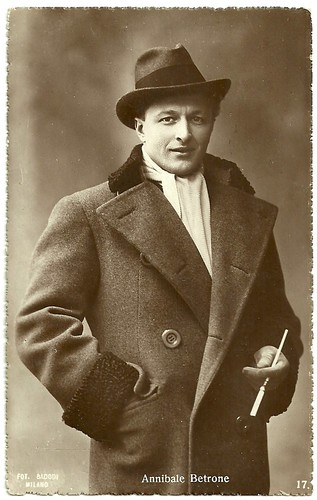
Italian postcard, no. 17. Photo: Badodi, Milano.

Italian postcard by Fotocelere, Torino. Photo: Badodi, Milano. The card was sent in 1921.

Italian postcard by Ed. Ballerini & Fratini, Firenze, no. 212. Annibale Betrone as The Jester, Oreste Bilancia as Floridoro, and Alberto Collo as Giano in L'arzigogolo (Mario Almirante, 1924). Caption: The Jester: Oh my pumpkin!... I could switch your head with that of a cow.

Italian postcard by Ed. Ballerini & Fratini, Firenze, no. 214. Photo: Alba Film. Annibale Betrone as The Jester, and Alberto Collo as Giano in L'arzigogolo (Mario Almirante, 1924). Caption: Giano to the Jester: ... if you don't manage to convince Violante of my love I will have your head chopped off!

Italian postcard by Ed. Ballerini & Fratini, Firenze, no. 222. Photo: Alba Film. Annibale Betrone as The Jester in L'arzigogolo (Mario Almirante, 1924). Caption: The Jester in prison.
Annibale Betrone was very active in cinema, though his silent parts were scarce. He began in 1916 with the silent films Tigrana (Edouard Micheroux de Dillon, 1916) and Alcova tragica/Tragic alcove (Edouard Micheroux de Dillon, 1916), both with Betrone, Mary Light, and Sergio Tofano.

Italian postcard by A. Traldi, Milano, no. 29. Photo: Badodi, Milano.

Italian postcard. Photo: G. Di Virgiliis, Genova. Annibale Betrone as Liliom in the play 'La leggenda di Liliom' by Hungarian playwright Ferenc Molnár. Liliom was one of Betrone's best-known stage roles.

Italian postcard by G. Vettori, Bologna, no. 435. Photo: Vettori, Bologna.
A strong dramatic, sometimes explosive, temperament
Annibale Betrone was born in Turin in 1883. Unlike many of his stage colleagues, he was no ‘figlio d’arte’, his father was a tailor, who was passionate about the stage. Annibale found a way to study acting with Domenico Bassi.
His debut came at the age of 17, in 1900, with the title of ‘second actor’ in the company of the brothers Marchetti. He was then hired by the company of Ermete Novelli, with whom he remained from 1901 to 1908. He passed the whole trajectory going from extra, to lover, to the young first actor, and finally the first actor.
He then moved over to Virgilio Talli’s company for a long period (1909-1921), where he established a famous triad with Maria Melato and Alberto Giovannini.
Between the two wars, he formed famous companies with some of the most reputed actresses, such as Maria Melato, Giannina Chiantoni, Tatiana Pavlova, Emma Gramatica, Paola Borboni, Kiki Palmer, Margaret Bagni, Olga Solbelli, and many more.
Betrone was an actor of a strong dramatic, sometimes explosive, temperament, and moved around within a vast repertory. He achieved great fame. Among his greatest successes are 'Il beffardo' by Nino Berrini and 'Glauco' by Ercole Luigi Morselli. He also played in 'Anfissa' by Leonid Andreev and in 'La sonata di Kreutzer' (The Kreutzer Sonata) by François Nozières, after Leo Tolstoy.
He was Bruneri-Canella in 'L’uomo no. 15' by E. Wool, and also recited in plays by Rosso di San Secondo ('Il delirio dell’oste Bassà') and Diego Fabbri. In 1945, in the just liberated Rome, he performed in 'The Moon is Down' by John Steinbeck, directed by Vito Pandolfi.
In the late 1930s, he had his own company, together with Anna Magnani. He directed her and Salvo Randone in several plays at the Roman Teatro Eliseo.
In 1940 he worked with Letitia Maria Celli and Angelo Calabrese, but after the outbreak of the war and the immediate post-war period, he reduced his presence on stage and focused on film acting.

Italian postcard, no. 17. Photo: Badodi, Milano.

Italian postcard by Fotocelere, Torino. Photo: Badodi, Milano. The card was sent in 1921.

Italian postcard by Ed. Ballerini & Fratini, Firenze, no. 212. Annibale Betrone as The Jester, Oreste Bilancia as Floridoro, and Alberto Collo as Giano in L'arzigogolo (Mario Almirante, 1924). Caption: The Jester: Oh my pumpkin!... I could switch your head with that of a cow.

Italian postcard by Ed. Ballerini & Fratini, Firenze, no. 214. Photo: Alba Film. Annibale Betrone as The Jester, and Alberto Collo as Giano in L'arzigogolo (Mario Almirante, 1924). Caption: Giano to the Jester: ... if you don't manage to convince Violante of my love I will have your head chopped off!

Italian postcard by Ed. Ballerini & Fratini, Firenze, no. 222. Photo: Alba Film. Annibale Betrone as The Jester in L'arzigogolo (Mario Almirante, 1924). Caption: The Jester in prison.
Breakthrough in the sound film
Annibale Betrone was very active in cinema, though his silent parts were scarce. He began in 1916 with the silent films Tigrana (Edouard Micheroux de Dillon, 1916) and Alcova tragica/Tragic alcove (Edouard Micheroux de Dillon, 1916), both with Betrone, Mary Light, and Sergio Tofano.
After this followed two films with Italia Almirante Manzini: L’innamorato/The lover (Gennaro Righelli, 1920) and L’arzigogolo/The Jester (Mario Almirante, 1924).
In the early 1930s. Betrone had a new breakthrough in the Italian sound film when he got a critical and public success playing king Vittorio Emanuele II in the feature film Villafranca (Gioacchino Forzano, 1934). A year earlier, he had also acted in Forzano's fascist propaganda film Camicia nera/Black shirt (Gioacchino Forzano, 1933).
Later he was admired as the human uncle in Piccolo mondo antico/Old-Fashioned World (Mario Soldati, 1941) - where he rivaled with the icy Ada Dondini - and the sensitive father of Doris Duranti in Nessuno torna indietro (Alessandro Blasetti, 1943).
During the war years, Betrone acted in some 26 films, ranging from propaganda films like Giarabub (Goffredo Alessandrini, 1942) to comedies like Teresa Venerdi (Vittorio De Sica, 1941) with Vittorio De Sica himself and Adriana Benetti, and (melo)dramas like the two-part film Noi vivi/Addio Kira! (Goffredo Alessandrini, 1943) with Alida Valli, Rossano Brazzi and Fosco Giachetti.
In 1912, Betrone had married Elvira Sanipoli - who later took the name of Elvira Betrone - and who often played with him on stage and on the screen, such as in the films Teresa Venerdi/Doctor, Beware (Vittorio De Sica, 1941), Noi vivi/We the Living (Goffredo Alessandrini, 1942), and Nessuno torna indietro/Responsibility Comes Back (Alessandro Blasetti, 1945).
Betrone was also the father of the young assistant-director, scriptwriter, and editor Gino (Cino) Betrone, who e.g. edited the film Tosca (1941) by Carl Koch and Jean Renoir. As lieutenant of the Alpine soldiers, he fell on the Greek-Albanian front in 1941.
Dedicated to his memory was the film Quelli della montagna/Those of the Mountain (Aldo Vergano, 1943) with Amedeo Nazzari and Mariella Lotti. Cino had delivered the idea for this film, and Annibale played a small part in it.
After the war Betrone was active for the radio. Among his last film roles were minor parts in two epics: Fabiola (Alessandro Blasetti, 1949) and Gli ultimi giorni di Pompei/The Last Days of Pompeii (Marcel L’Herbier, Paolo Moffa, 1950), starring Micheline Presle and Georges Marchal.
Annibal Betrone died in Rome in 1950. His wife Elvira Betrone died in Milan in 1961.
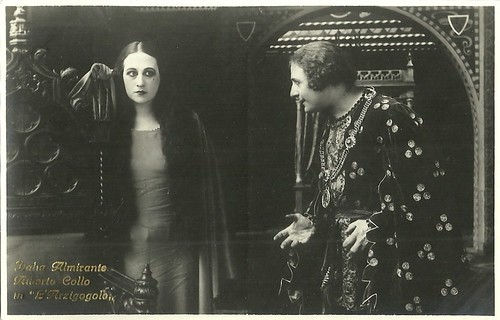
Italian postcard by G.B. Falci, Milano, no. 209. Photo: publicity still for L'arzigogolo (Mario Almirante 1924), with Italia Almirante Manzini and Alberto Collo.

Italian postcard by G.B. Falci, Milano, no. 209. Photo: publicity still for L'arzigogolo (Mario Almirante, 1924).
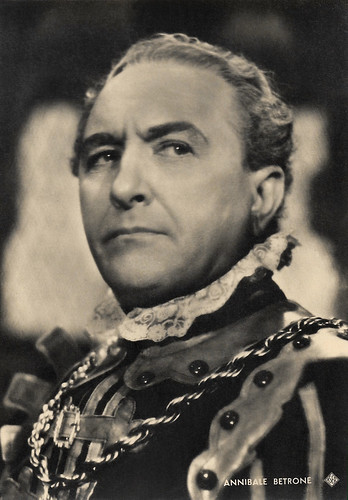
Italian postcard by ASER (A. Scarmiglia Ed. Roma), no. 80. Photo Pesce / Scalera Film. Could be a publicity still for the period piece La Gorgona (Guido Brignone, 1942) in which Betrone played count Ranieri.

Italian postcard, no. 301.
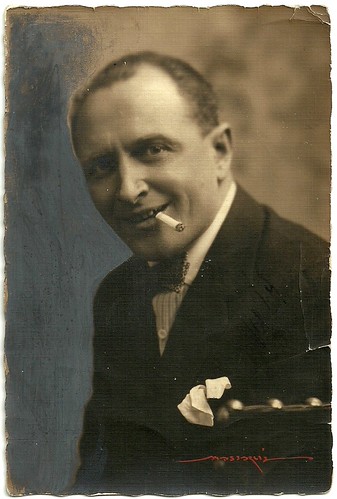
Italian postcard. Photo Massaglia, Torino.
Sources: Wikipedia (Italian) and IMDb.
This post was last updated on 7 March 2021.
No comments:
Post a Comment